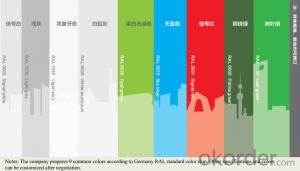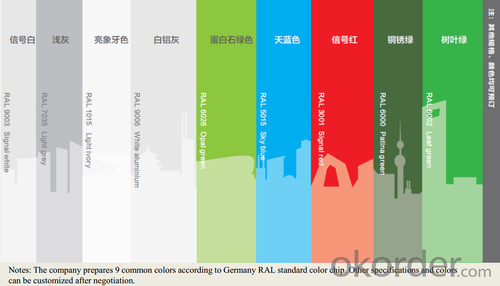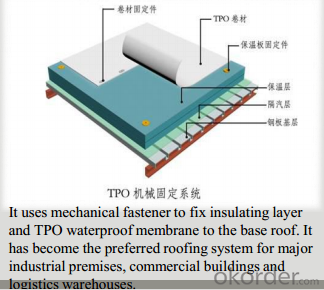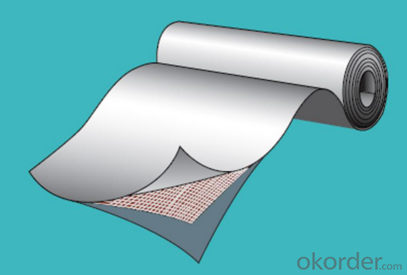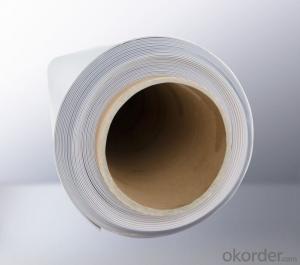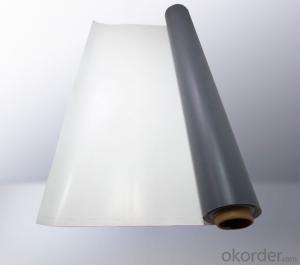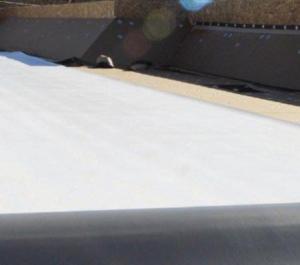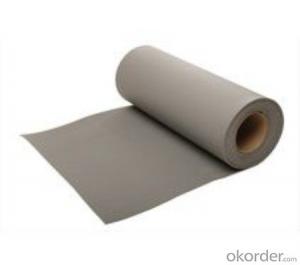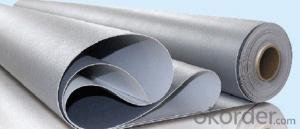PMT Thermoplastic Polyolefin(TPO) Waterproof Sheet
- Loading Port:
- Shanghai
- Payment Terms:
- TT or LC
- Min Order Qty:
- 4000 m²
- Supply Capability:
- 100000 m²/month
OKorder Service Pledge
OKorder Financial Service
You Might Also Like
PMT-TPO is a waterproof sheet, consisting of thermoplastic polyolefin compound resin materials as the base stock, reinforced with fiber backing materials.
This kind of coiled material can be welded, and has good weather resistance and excellent Low-temperature Capability .
There have two kinds of thickness: 1.2mm and 1.5mm.
1. Main Features
Standards
ASTM D6878
Item | Requirement | Test Method | ||
Thickness, min, mm | Sheet-overall | ≥1.0 | ASTM D6878 | |
Coating over fabric or scrim, weathering side only | ≥0.305 | ASTM D751 | ||
Breaking strength, min, N | ≥976 | ASTM D751 | ||
Elongation at reinforcement break, min, % | ≥15 | ASTM D751 | ||
Tensile strength,min, N | ≥245 | ASTM D751 | ||
Brittleness point, max, °C | ≤-40 | ASTM D2137 | ||
Ozone resistance | no cracks | ASTM D1149 | ||
Properties after heat aging | Breaking strength, % min | ≥90 | ASTM D573 | |
Elongation at reinforcement break, % min | ≥90 | ASTM D573 | ||
Tearing strength, % min | ≥60 | ASTM D573 | ||
Weight change (mass), max % | ≤±1 | ASTM D573 | ||
Linear dimensional change, max, % | ≤±1 | ASTM D1204 | ||
Water absorption, max, mass % | ≤±3.0 | ASTM D471 | ||
Factory seam strength, min, N | ≥290 | ASTM D751 | ||
Weather resistance | Visual inspection | - | ||
2. Packaging
Rolled with hard materials and packed with plastic bags or woven bags.
Thickness | Roll Size | Rolls/Pallet | Pallets / 20’ Container |
1.2 mm | 15 m2 | 25 | 20 |
20 m2 | 25 | ||
30 m2 | 25 | ||
1.5 mm | 15 m2 | 25 | |
20 m2 | 25 | ||
30 m2 | 20 |
3. Applications
Various roofing waterproof projects, such as industrial and civil buildings, public constructions;
Full adhered system for concrete substrate or mechanically attached systems.
4. Advantages
Weather resistance and durability;
Excellent weld ability;
No any crisp agents to prevent materials brittleness;
White-based light-color and smooth surface with high reflection, energy saving and anti-dust functions;
Use heat welding for the seam areas to form a reliable seamless waterproof layer.
Intermediate enhanced polyester mesh fabric to have high tensile strength, fatigue resistance and penetrating resistance suitable for mechanically attached roofing systems;
Excellent the same high and low temperature resistance as rubber materials which can keep flexible at -50° C and keep mechanical strength in high temperature;
Excellent chemical resistance to acids, bases, and restaurant exhaust emissions;
Dimension stability;
5. How to Constrution TPO sheet?
For Mechanically Attached Roofing System
Before application, spread TPO membranes on substrate in advance. Install TPO membranes perpendicular to steel deck ribs on the substrate without distortions according to the flange. The overlapping width is 120 mm. The minimum overlapping distance of membrane short side direction is 50 mm. Fasteners are installed according to designed position. Hot-air welding is adopted for laps with 40 mm welding width.
For Fully Adhered Roofing System
Before application, spread TPO membranes on substrate in advance. Install TPO membranes on the substrate without distortions according to the flange. The overlapping width should be more than 50 mm. Hot-air welding is adopted for laps with 40 mm welding width. Professional adhesives need to be used on both underside and substrate surfaces to adhere and maintain.
For Ballasted Roofing System
Before application, spread TPO membranes on substrate in advance. Install TPO membranes on the substrate without distortions according to the flange. The overlapping width should be more than 50 mm. Hot-air welding is adopted for laps with 40 mm welding width.
6.Storage
PMT-TPO material should be stored in well-ventilated place and avoid being exposed to the sun or rain. The temperature in stored places can not be higher than 45° C. It only can be put horizontally in five-level. It has to be avoided acid, alkali, oil and organic solvents. The shelf life is 1 year.
7. Transportation
PMT-TPO material should avoid inclination or lateral drift during transportation. When necessary, covering with felted fabric.
8. Attentions
TPO membranes reflect heat and light, wearing protective clothing (long-sleeved shirt, long-barreled trousers), and wearing a filter to protect the skin and eyes from UV-induced damage.
Security measures for roof perimeter are necessary when application. Sheet surface is slippery when wet, taking care to avoid slide.
Sealants and adhesives are flammable containing solvents. They will be dangerous when exposure to heat, even have the possibility to catch fire and explode.
Sealants, adhesives, cleaners should be avoided contacting with skin and eyes.
No smoking during application.
9.Certificate:
Meanwhile, it has obtained FM certificate of the US, CE certificate of EU, and Gost-R certificate of Russia with its more stable properties and excellent performance.
- Q: Can a waterproofing membrane be used for a commercial building?
- Indeed, a commercial building can utilize a waterproofing membrane. Specifically engineered to safeguard structures against water damage, these membranes find wide application in commercial settings, encompassing rooftops, basements, and foundation walls. Serving as a protective barrier, the membrane effectively prevents water infiltration, safeguarding against leaks, moisture accumulation, and the growth of mold. Moreover, waterproofing membranes exhibit durability, enabling them to withstand inclement weather conditions, rendering them suitable for commercial buildings exposed to heavy rainfall or extreme temperatures. Ultimately, the incorporation of a waterproofing membrane within a commercial building proves highly effective in preserving long-term structural integrity and averting costly water-related impairments.
- Q: Can a waterproofing membrane be applied on top of existing roofing systems?
- The application of a waterproofing membrane on existing roofing systems is a common practice in the roofing industry. This method enhances the waterproofing capabilities of the roof by preventing water infiltration. The membrane, which can be made of materials like asphalt, rubber, or synthetic materials, is installed to create a layer that stops water from seeping through. Before applying the waterproofing membrane, it is crucial to evaluate the condition of the existing roof. Any damage or defects should be fixed to provide a solid foundation for the membrane. Additionally, the surface must be thoroughly cleaned and prepared to ensure proper adhesion of the membrane. Once the surface is prepared, the waterproofing membrane can be applied using different methods such as hot-mopping, torching, or adhesive application. Multiple layers of the membrane are typically installed to offer extra protection against water penetration. The application of a waterproofing membrane on top of an existing roofing system offers several advantages. It extends the lifespan of the roof by preventing water damage and leaks. Moreover, it enhances the energy efficiency of the building by reducing heat transfer and air leakage. Additionally, it improves the overall waterproofing capabilities of the roof, safeguarding the underlying structure from moisture-related problems. To determine the most suitable waterproofing membrane and installation method for your specific roofing system, it is essential to consult with a professional roofing contractor. They will evaluate the condition of the existing roof and recommend the best approach to ensure a successful application of the waterproofing membrane.
- Q: Can a waterproofing membrane be used on metal block surfaces?
- Yes, a waterproofing membrane can be used on metal block surfaces. Waterproofing membranes are designed to create a barrier against water and moisture, and they can be applied to a variety of surfaces, including metal. The membrane will adhere to the metal surface, creating a waterproof layer that helps prevent water infiltration and protect the metal from rusting or corrosion. However, it is important to ensure that the metal surface is clean, dry, and properly prepared before applying the waterproofing membrane to ensure proper adhesion and effectiveness. Additionally, it is recommended to consult with a professional or refer to the manufacturer's instructions for specific guidance on using a waterproofing membrane on metal block surfaces.
- Q: Can a waterproofing membrane be painted or coated?
- Indeed, it is possible to paint or coat a waterproofing membrane. However, it is crucial to utilize a paint or coating specifically formulated for application on waterproofing membranes. Typically, these types of paints or coatings possess elastomeric properties, enabling them to stretch and flex along with the membrane, preventing any cracking or peeling. Moreover, it is vital that the paint or coating is compatible with the material of the waterproofing membrane to ensure proper adhesion and long-lasting results. Prior to applying any paint or coating, it is advisable to thoroughly clean and prepare the surface in accordance with the manufacturer's instructions. Additionally, adhering to the recommended application process and allowing ample time for the paint or coating to dry and cure is of utmost importance. Overall, painting or coating a waterproofing membrane can enhance its visual appeal, offer added protection against UV rays and environmental elements, and prolong its lifespan.
- Q: Can a waterproofing membrane be used on concrete block surfaces?
- Yes, a waterproofing membrane can be used on concrete block surfaces. Waterproofing membranes are designed to provide a barrier against moisture and water penetration, and they are commonly used on concrete block surfaces to protect against water damage and leaks. These membranes are typically applied as a liquid or sheet material and adhere to the surface of the concrete blocks, creating a protective layer that prevents water from seeping through. The waterproofing membrane helps to extend the lifespan of the concrete blocks by reducing the risk of water damage, mold growth, and deterioration. It is important to choose a waterproofing membrane that is specifically designed for concrete block surfaces and follow the manufacturer's instructions for proper installation to ensure the best results.
- Q: Can a waterproofing membrane be used for below-grade parking structures?
- Below-grade parking structures may utilize a waterproofing membrane to prevent water infiltration and safeguard against water-related damage. This type of membrane is frequently employed in construction to create a barrier against water and its detrimental effects. Considering the nature of below-grade parking structures, which are either fully or partially underground, the surrounding soil and groundwater pose an increased risk of water seepage. To counteract this, waterproofing membranes are applied to the exterior surfaces of the structure. These membranes, typically composed of materials like bitumen, rubberized asphalt, PVC, or polyurethane, exhibit exceptional resistance to water penetration. Moreover, certain membranes may possess additional attributes such as crack-bridging capabilities or protection against chemicals or gases. For the optimal selection of a suitable membrane for a specific below-grade parking structure, it is vital to consult with an experienced engineer or waterproofing specialist. Factors such as soil conditions, hydrostatic pressure, and adherence to local building codes must be carefully considered in this decision-making process.
- Q: Does a waterproofing membrane have any impact on the appearance of a surface?
- Yes, a waterproofing membrane can have an impact on the appearance of a surface. Depending on the type and application method of the membrane, it may add a layer of protection that alters the texture, sheen, or color of the surface. Additionally, some membranes may be visible or create a slightly raised or textured effect on the surface. However, there are also transparent or thin membranes available that have minimal impact on the appearance of the surface.
- Q: Modified asphalt waterproofing membrane SBS I G PE4 What does it mean?
- SBS is called the elastomer modified asphalt waterproofing membrane, I on behalf of the model, GK is the tire base for the polyester tire base, PE four on behalf of the membrane for the double-sided PE film four mm thick.
- Q: Are waterproofing membranes breathable?
- No, waterproofing membranes are not typically breathable. They are designed to prevent water penetration, but this also means that air cannot easily pass through them.
- Q: Can a waterproofing membrane be used on elevator pits?
- Yes, a waterproofing membrane can be used on elevator pits. Elevator pits are vulnerable to water damage due to their location below ground level and the potential for water infiltration. Installing a waterproofing membrane in the elevator pit can help protect the structure from water damage and prevent issues such as corrosion, mold growth, and deterioration. The membrane acts as a barrier, preventing water from seeping into the pit and causing damage to the elevator equipment or the surrounding structure. It is important to select a waterproofing membrane specifically designed for below-grade applications and to ensure proper installation to achieve effective waterproofing in elevator pits.
Send your message to us
PMT Thermoplastic Polyolefin(TPO) Waterproof Sheet
- Loading Port:
- Shanghai
- Payment Terms:
- TT or LC
- Min Order Qty:
- 4000 m²
- Supply Capability:
- 100000 m²/month
OKorder Service Pledge
OKorder Financial Service
Similar products
Hot products
Hot Searches
Related keywords
